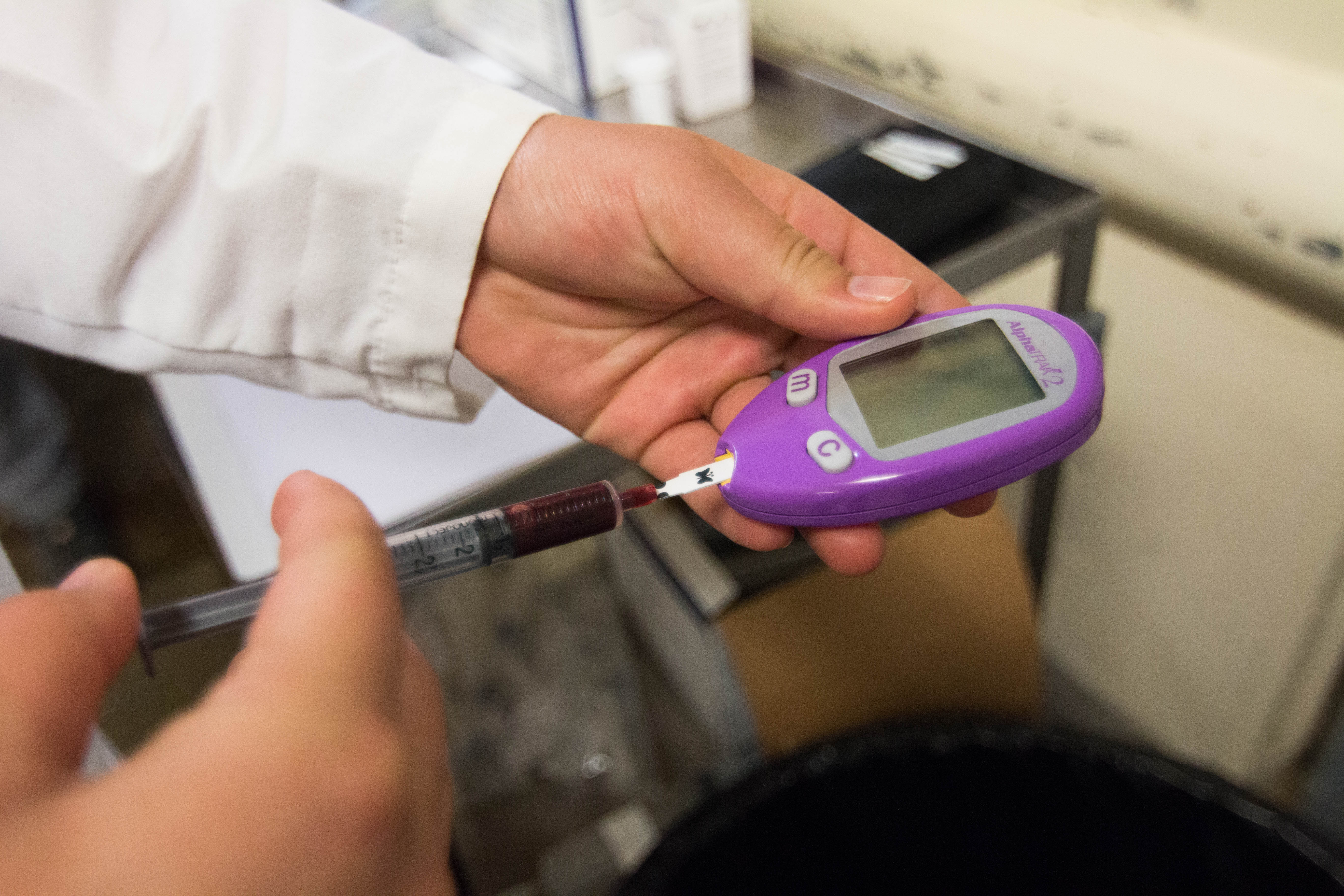General information
Equine metabolic syndrome (EMS) is a disorder of the endocrine system that’s a major concern to horse owners because of its association with recurrent or chronic laminitis. Often compared to Type 2 diabetes in people, EMS is characterized by obesity and insulin resistance — an impaired response to insulin that causes glucose levels in the blood to remain high.
What are the risk factors and symptoms of EMS?

EMS tends to develop in horses and ponies from the hardier breeds such as saddlebred, Tennessee walking horse, paso fino, Morgan, mustang, Arabian and quarter horse. Since these breeds evolved from ancestors that survived on very little nutrition, it appears that their metabolism isn’t compatible with today’s typical equine diet. As a result, they can easily become over-conditioned and are often described as “easy keepers” – capable of gaining weight without eating very much.
In addition to body condition, an important indicator of EMS is the development of fat deposits — typically on the neck, shoulders and rump.
However, the most significant and distressing symptom of EMS is the onset of laminitis, a devastating, painful disease caused by inflammation of the tissue layer that connects the hoof bone to the hoof capsule. It’s a chronic disease that can lead to structural changes inside the hoof. Once these changes occur, the disease is very difficult and sometimes impossible to manage. Horses that have developed laminitis are always at risk for another episode, and in many cases, they are never able to return to their normal life.
Because laminitis can affect an animal’s quality of life and may ultimately lead to its death, horse owners need to be aware of the risk factors for EMS. If they can recognize the early clinical signs, they may be able to prevent laminitis from developing.
What should I do?
Diagnosis

If you suspect that your horse may have EMS, contact your veterinarian. Veterinarians can make a preliminary diagnosis of EMS based on the animal’s physical appearance as well as its medical history, which often includes recurrent episodes of laminitis.
As well, veterinarians can conduct some diagnositc testing. The recommended diagnostic tests are the oral sugar test (OST) or the insulin tolerance test (ITT).
In normal horses, the blood glucose level decreases over time as the insulin drives the glucose out of the bloodstream and into the cells. In horses that have EMS, blood glucose levels in horses tend to be normal but insulin levels can be high. Persistently elevated blood glucose would be suggestive of type II diabetes mellitus. This condition is less common in horses, but it does occur.
Treatment

Although EMS can never be cured, it can be managed with diet and exercise. The body condition of horses is often measured on a scale of one to nine with a score of seven or greater being considered overweight. The goal of any management program should be to drop the horse’s body condition score to below a seven (ideally five) and then maintain that condition.
EMS horses should be placed on a low-carbohydrate diet and fed one to 1.5 per cent of their body weight in dry matter. The normal daily requirement for horses is about two per cent of their body weight.
Horse owners can soak hay to leach out some of the soluble carbohydrates or feed a lower-quality hay that has fewer carbohydrates. To ensure that the animals receive all their required nutrients, it’s a good idea to have a feed analysis done on the hay to determine what vitamins and minerals need to be added to their diet.
Since horses are herd animals that don’t like to be separated from the others, it can be beneficial to let EMS horses out to pasture with the rest of the herd, but only if their grass intake is well controlled. One recommendation is to use a grazing muzzle so they can be with the other animals even though their access to grass is limited. If there are several EMS horses in the herd, they might be pastured together in a separate area.
For example, carbohydrate levels are lower at night, so a feeding strategy could involve turning the horses out at night and then bringing them back in during the day.
Timing is also an important consideration. The recommended time for turn out is early morning, based on the rationale that the grass uses up stored carbohydrates over night, meaning its carbohydrate stores are lowest early in the morning.Horse owners should also be aware that spring and early fall after the first frost are particularly risky times for EMS horses to be pastured because the grass is much richer in carbohydrates during those periods.
Regular exercise is an important aspect of the weight loss program. However, it’s not recommended for animals that are having an acute episode of laminitis since it might actually worsen their condition.
For EMS horses that are sound, it’s important to establish a regular exercise program that starts with just a few minutes at a time and increases as they become better conditioned. Carefully monitor each animal and immediately stop the exercise program if there are any signs of laminitis.
How are EMS and PPID different?
Although laminitis is a symptom of both EMS and pituitary pars intermedia dysfunction (PPID), they are distinct conditions that involve two separate hormone disorders. In addition, PPID affects a horse’s appearance differently because it often causes significant muscle wasting. Animals with the disease may get a pot belly, but they usually appear skinnier than those with EMS.
Unfortunately, both EMS and PPID can occur at the same time, and there’s some evidence that an EMS horse may be more susceptible to developing PPID. For that reason, owners should carefully monitor EMS horses for any indications of PPID.
Can EMS be prevented?
The key to preventing EMS is awareness, but sometimes even the most diligent horse owners are unable to prevent their horse from developing laminitis — often the first indication of the disorder.
If you own a horse that’s predisposed to developing EMS, monitor its body condition carefully so that it never becomes over conditioned, and be aware of the clinical signs — the cresty neck and the fat deposits. Talk to your veterinarian about your concerns. The ultimate goal is early detection to prevent laminitis from occurring.
New research
EMS is a very active area of equine health research. A major focus of investigation is the connection between inflammation and metabolism. There’s more and more evidence that EMS is a metabolic problem that’s not only connected to hormones but also to inflammation and immune response.
Another important research area involves the diagnosis of EMS. Researchers at the Western College of Veterinary Medicine (WCVM) are conducting a unique study aimed at enabling veterinarians to diagnose EMS earlier, before the animals begin to show clinical signs and especially before they develop laminitis.
The WCVM research team is investigating a diagnostic tool that’s proved effective in human medicine where doctors are able to make an early diagnosis of Type 2 diabetes based on the measurements of two metabolites in the blood: D-lactate and methylglyoxal (MG).
By comparing the blood tests of healthy horses and EMS-positive horses, the researchers will determine if EMS also causes differences in these two metabolites. If D-lactate and/or MG can be used as biomarkers for EMS, that information will be significant for making an earlier diagnosis.
If horse owners can get an early EMS diagnosis, they can begin managing their horses’ diet and exercise earlier. And they’ll have a better chance of saving their animals from developing laminitis – that’s the best outcome for everyone.
Recent EMS-related research from the WCVM:
- V.M. Ragno*, G.A. Zello, C.D. Klein*, J.B. Montgomery, 2019. "From table to stable: a comparative review of selected aspects of human and equine metabolic syndrome." Journal of Equine Veterinary Science, 79: 131-138; DOI: 10.1016/j.jevs.2019.06.003.
- V.M. Ragno*, N.S. Sereda*, E. Dudko*, D.L. Michel, G.A. Zello, K.A. Robinson, F.D. Uehlinger, J.B. Montgomery, 2018. "A comparison of the stability of equine blood d-lactate in sodium fluoride and serum tubes." Journal of Veterinary Internal Medicine, 32: 2187.
- V.M. Ragno*, F.D. Uehlinger, K.A. Robinson, G.A. Zello, J.B. Montgomery, 2018. "Investigation of novel biomarkers for early detection of equine metabolic syndrome." Journal of Veterinary Internal Medicine, 32: 2182.
Dr. Julia Montgomery is a board-certified specialist in large animal internal medicine at the Veterinary Medical Centre and an associate professor at the Western College of Veterinary Medicine (WCVM).
EquineED Talk
As part of the WCVM's EquineED Talks series for the horse community, WCVM associate professor Dr. Julia Montgomery gave the following presentation on equine metabolic syndrome (EMS) and pituitary pars intermedia dysfunction (PPID).
News
Horse Health | WCVM
Stories related to PPID
- Hormone baselines for horses in the West
- Reining in equine obesity
- Researchers use human medicine to further equine research
- Early detection of EMS has big benefits
Loading...

